J. Will Evans
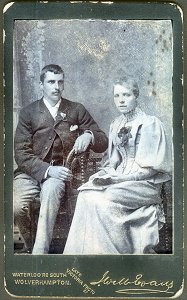 |
The captions on both photos give the address of
Waterloo Road South but also says "Late Victoria Photo Co."
That company (see later) was at 44 Waterloo Road.
The furniture here would have been studio props. There is an
elaborate painted back cloth of vaguely classical style. |
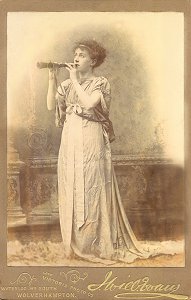 |
|
The left hand photo may be of a recently wed young
couple. On the back of the photo on the right is an ink inscription
which seems to
read: "Theresa Sankey about /95". Could this be a young member of
the Joseph Sankey family?
Henri Gascon
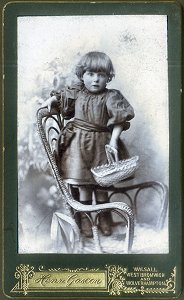 |
The inscription on the two photographs lists
premises in Walsall, West Bromwich, and Wolverhampton. David Simkin
tells us that Henri Gascon was also a
Brighton photographer; and Margaret Sheldon Bellanger told us
she had found a Henri C. Gascon, described as a photographer
from England, in the census in Kansas in 1910. |
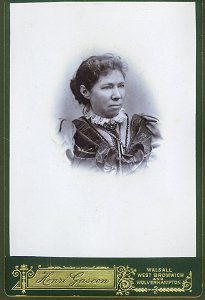 |
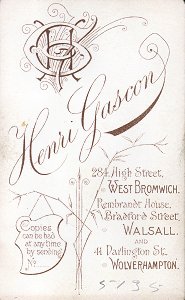 |
David Simkin (whose has a comprehensive website of Brighton
photographers) has now sorted it all out, with information
gleaned from a variety of sources. |
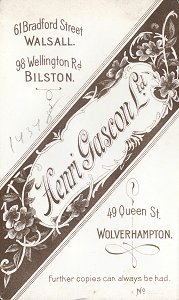 |
David Simkin writes:
"Henri Charles Membrey Gascon was born around 1870. He was born in
England but his name suggests his father was French or possibly from
the Channel Islands.
In 1893, Henri Gascon was in Wolverhampton. During the
September quarter of 1893, Henri Membrey Gascon married Ellen
("Nellie") Cecelia Brennan in the district of Wolverhampton.
The couple's first child was Dorothy Helena Gascon who was born in
Wolverhampton during the September Quarter of 1894. (The
Gascon family may have been in Liverpool at the end of 1895 - the
birth and death of a child named Charles Gascon was registered in
Liverpool during the December quarter of 1895 ).
By 1896, Henri Gascon was in Walsall. Henri Gascon's
photographic studio at Rembrandt House, Wednesbury Road, Walsall is
listed in Kelly's 1896 Directory of Staffordshire. Henri
Gascon's branch studio at 284 High Street, West Bromwich is also
listed in the 1896 Directory. Henri Gascon and his family were
residing in Walsall at this time - a son, named Lucian Gascon, was
born in Walsall during the March Quarter of 1896, but, sadly, died
soon afterwards. A second son was born in Walsall during the March
Quarter of 1897. This boy was given the name of Henri Lucian
Gascon, but he was generally known by his second name, Lucian.
Another son, Charles Lionel Gascon was born in Walsall during the
March Quarter of 1899. A daughter, named Mary Helen or Helen
Mary, was born around 1900.
Although Henri Gascon and his family were residing in Walsall in
the period 1896-1900, he was also running branch studios in West
Bromwich, Wolverhampton, and Birmingham in the late 1890s.
Rembrandt House, Wednesbury Road, Walsall
(1893?) 1896 -1897
Rembrandt House, 61 Bradford Street, Walsall
1897-1899
284 High Street, West Bromwich
1896-
41 Darlington Street, Wolverhampton
1897-1898
49 Queen Street, Wolverhampton
1897?-1904(1903)
197 Bristol Street, Birmingham
1897
98 Wellington Road, Bilston
1899
After 1900, Henri Gascon was operating as a photographer in the
South of England. (A child named Annie Gascon was born in London in
1903 but this might be from a different family). In 1903,
Henri Gascon and his family were in Canterbury, Kent. Henri
Gascon is listed as a photographer at 28 St Peter's Street,
Canterbury in Kelly's 1903 Directory and a child named Agnes Idalia
Gascon died in Canterbury in the December Quarter of 1903, aged one
year. By 1904, Henri Gascon was in Brighton. Henri Gascon was
listed as a photographer at 4 Richmond Terrace in Kelly's 1905
Sussex Directory. Two Gascon children were born in Brighton:
Gladys Mary Gascon in the June Quarter of 1904, and Ralph Leslie
Gascon during the March Quarter of 1906.
Before the end of 1906, Henri Gascon had emigrated to the USA. A
daughter named Audrey was born in Kansas around 1909 and Henri
and Nellie Gascon with six of their children are listed in the 1910
census for Rosedale City, Kansas. By January 1920, the Gascons were
living in Kansas City, Missouri. The two census returns show that
Henri Gascon continued his career as a photographer in the USA."
Many thanks to David for that remarkable research.
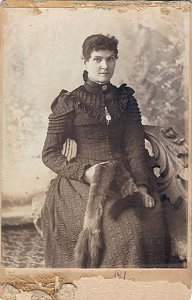 |
Chris Hood has sent this photo which mentions the studio
at 197 Bristol Street, Birmingham.
The lady, who is holding a tippet, is Chris's great
grandmother, Anice Hood (nee Kilner). She lived in
Cregoe Street, only a short walk away from the Bristol
Street studio. Chris thinks this photo dates to the first
half of 1897. |
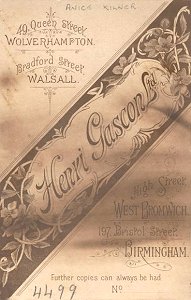 |
Gustave Guggenheim
|

Courtesy of Elizabeth
Bowsher. |
This photo is believed to be of Elizabeth
Bowsher's great great uncle,
Thomas Henry Jenkins (1869-1908) and his wife, Jane Ellen
Albiston (1870-1849). Possibly taken at
about the time they married, in 1895. The
reference on the photo to Guggenheim at the Theatre Royal
Studios in 1894, was perhaps at the time of their engagement.
He was a tool setter. |
| Gustave George Guggenheim (1866-1929). Courtesy
of Elizabeth
Bowsher. Gustave was born in 1866 in Oxford,
the fourth child of Jules N. Guggenheim and his wife,
Elizabeth. Jules was a Hungarian national and a
photographer. By 1881 Gustave was assisting in his father’s
photography business.
Gustave married Gertrude Cowern in Wolverhampton in
December 1890 and they had 7 children. He was listed in the
register as a photographer and living in Tunbridge Wells,
Kent. In December 1891 Gustave was mentioned in the London
Evening Standard as having provided the illustrations for
the "Travels and Adventures of an Orchid Hunter", by Albert
Millican, published by Cassell & Company. In 1892 he was
mentioned in the Kent & Sussex Courier as having
demonstrated how to re-touch photographs at a meeting of the
Amateur Photographic Society, held at the Mechanics
Institute.
In 1894 Gustave was listed along with Arthur Albery Major
as a photographer at the Theatre Royal Studio, Old Hall
Street. They had premises in Old Hall Street and St John's
Square. Their business, Guggenheim & Major was dissolved in
October 1894.
In May 1896 an action was brought for infringement of
copyright by Guggenheim & Whitlock, trading as Arthur &
Company, photographers at Darlington Street, Wolverhampton
and Snowhill, Birmingham. The action concerned a photograph
taken by them of Wolverhampton Wanderers in April 1896. The
real issue was that Guggenheim & Whitlock were not acknowledged as the
photographers and they were suing for consequent losses of
sale of copyright photograph. In effect, Gustave and
Whitfield lost and in June 1896 also lost an appeal. In
August 1896 Gustave and Arthur Whitlock dissolved their
partnership and carried on in business at Darlington Street
as photographers.
From 1896 to 1898 Gustave was listed as a photographer at
33 St John Square (and also at 49 Snow Hill in 1896). From
1900 to 1904 Gustave was listed in Allen Road,
Wolverhampton.
In March 1902 a partnership was dissolved between Jules
Sigismund Guggenheim (Gustave’s brother) and Gertrude
Elizabeth Guggenheim (Gustave's wife), carrying on in
business as photographers in Swindon and City Chambers,
Birmingham, as Guggenheim and Company.
In April 1904 a partnership was dissolved between
Gertrude (Gustave’s wife) and Frank Bernard Smythe, carrying
on in business as photographers at City Chambers, 82 New
Street, Birmingham, as Guggenheim and Company. The business
was to be continued by Gertrude.
In March 1905 a partnership was dissolved between
Alphonse Labarre of Stourbridge and Gertrude (Gustave’s
wife), carrying on in business as photographers at City
Chambers, Birmingham, as Guggenheim and Company. The
business was to be continued by Frank Bertrand Smythe of
Stourbridge.
In 1908 the Guggenheim’s were listed at Bilston Street
and in 1910 in Snow Hill.
Gustave was listed from 1910 to 1912 in Electoral
Registers and on the Census, at Newhampton Road,
Wolverhampton and from 1913 to 1928 at Compton Road.
In 1914 a case was bought by a young man who had been
apprenticed to H. J. Whitlock & Sons and who claimed that he
had not been properly instructed. Gustave was called as a
witness and described as "head artist" and said that the
plaintiff "showed no inclination to tackle the serious work
of the business."
Gustave died in Wolverhampton in 1929 and Gertrude died
in 1946 in Codsall. |
A. B. Hart
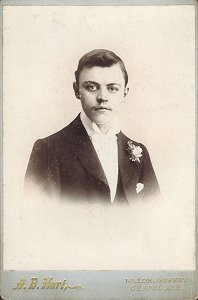 |
Hart's address is 148 Lord Street, Chapel Ash.
There seem to have been several Harts in Wolverhampton
photography. One of them was an assistant to Bennett Clark
and took over his business. In later times there was a
Charles Hart. |
|
E. Haseler
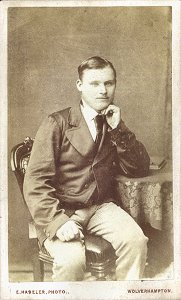 |
Haseler's address is shown as 25 Queen Street and
he proclaims himself as "Artist and Photographer". He also
claims to be the "sole licensee for the beautiful Van de Wade
process" - whatever that was.
The card back also says "Estates photographed on the shortest
notice". |
 |
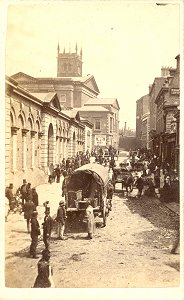 |
This carte de visite
carries his famous photo of Cheapside. It shows the
Exchange still present but without its dome. The Exchange was
built in 1850, the dome removed in 1851 and the whole demolished
in 1898. |
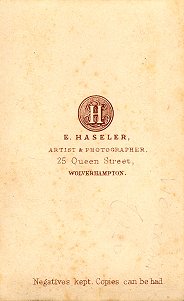 |
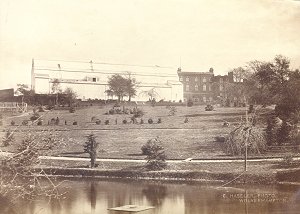 |
This is not a carte de visite but a 5.5 by 4 inch
albumen print by Haseler. It shows the Molineux grounds during
the preparation for the industrial exhibition of 1878. |
It seems that Haseler's interests were not confined to
photography but extended at least as far as industrial art. In G.
Phillips Bevan's "British Manufacturing Industries", 1876, there is a
chapter on papier mache by George Lindsay. In it he talks about
methods of decorating papier mache japanned wares and inventions y which
the amount of hand labour involved could be considerably reduced.
And he says "In 1852 Mr. Haseler, of Wolverhampton, patented what was
called 'the negative process for producing ornamentation in burnished
gold upon japanned or other bright surfaces'". On a lithographic
stone or copper plate a pattern was made of the areas of the japanned
piece which were not to be in gold. A thin paper print was
taken from the stone or plate and placed on the japanned piece.
Gold leaf was then applied to the whole surface, with a size "composed
chiefly of isinglass and water". When it was dry, the whole
surface was rubbed over with spirits of turpentine which dissolved the
paper negative, so that it and the gold leaf on it was removed leaving
only the desired areas covered in gold. "This process was worked
satisfactorily for some years by one of the leading houses of
Wolverhampton" - presumably either Walton or Loveridge. (At about
the same time Mr. C. Breese invented a positive process; but Haseler's
system was simpler and Breese's "was applied almost exclusively to glass
and porcelain surfaces").
James Morley has very kindly provided us with some
photos which he has found in an album of cartes de visite which he
acquired in late 2006. He is still studying this very interesting
collection which includes important photos by Mrs. Williams (qv)
and W. H. Dodds (previously only identified as the predecessor of C.
Stallard (qv). And it also includes this remarkable photo:
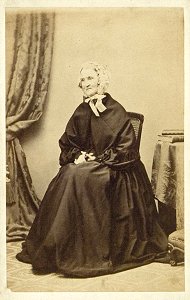 |
The identification of the sitter as
Haseler's mother is probably reliable. The date of
1858 or 1859 seems very early but doubtless could be
confirmed by experts in fashions or photographs. Of
course, the photo could have been taken long before it was
printed on a carte de visite. |
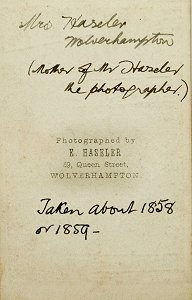 |
Note that on this carte Haseler's address is given as 59
Queen Street, whereas the other cartes show 25 Queen Street. This
may show that he moved (from 59 to 25?) or that the street was
re-numbered.
 |
|
 |
| Return to
the beginning |
|
Proceed to
the next page |
|

